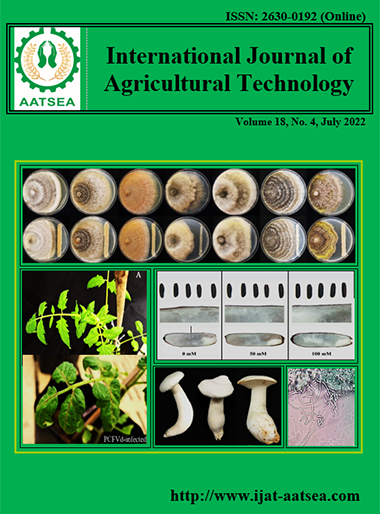Olive oil quality characteristics of olive orchards (Olea europaea var. euroupaea L.) in a semi-arid continental zone: Case of the Beni Mellal-Khenifra region in Morocco
Main Article Content
Abstract
The physical and chemical analysis of the quality of olive oil trees (Olea europaea var. euroupaea L.) in the years of 2017-2019 period at continental environment with semi-arid climate, Beni Mellal-Khenifra land's, located in central Morocco is revealed territorial specifications. Four homogeneous agricultural territorial units were identified. Result showed the plain with great hydraulic irrigation, the pluviometric plain with private irrigation pumping, the piedmont zone (alias "Dir" zone) and the medium mountain zone. These spatial units had showed significant differences in the values of the essential parameters of quality of the olive oil. The percentage free acidity content were 0.96, 1.76, 1.19 and 1.31, peroxide index (with meq/ O2/kg) were 7.38, 6.34, 10.00, 7. 09, the two specific extinctions under ultraviolet radiation at wavelength 232 nm showed 0.94, 1.34, 0.79 and 0.74, respectively. The wavelength at 270 nm showed non significant difference in the values of 0.08, 0.09, 0.15 and 0.08. It is found that the agricultural territorial unit "the plain of great hydraulic irrigation" presented significantly the best quality of olive oil. It was nearly equal frequence of class of extra virgin oil (50.02 %), and class of virgin oil (49.48 %). The performance of area is explained by the fertility of the soils, the judicious choice of the plant material, the relatively young age of the olive orchards, the suitable levels of technicality of the local olive growers, and also the respect of the good practices of hygiene by the crushing units with improved mode within the studied area.
Article Details

This work is licensed under a Creative Commons Attribution-NonCommercial-NoDerivatives 4.0 International License.
References
Ait Yacine, Z., Hilali, S. and Serhrouchni, M. (2001). Estudio de algunos de los parámetros para determinar la fecha de recolección de las aceitunas en la zona de Tadla. Olivae: revista oficial del Consejo Oleícola Internacional, 88:39‑45.
Boskou, D. (2006). Characteristics of the Olive Tree and Olive Fruit in: Olive Oil: Chemistry and Technology, pp.13-20.
Bouhafa, K. (2016). Références pour la fertilisation raisonnée de l’olivier dans la région de Sais. These de doctorat en sciences du sol. Institut Agronomique et vétéraiaires Hassan II. Maroc.
Boulfane, S., Maata, N., Anouar, A. and Hilali, S. (2015). Caractérisation physicochimique des huiles d’olive produites dans les huileries traditionnelles de la région de la Chaouia-Maroc. Journal of Applied Biosciences, 87:8022-8029.
C.O.I. (2015). Conseil Oléicole International :COI/T.20/Doc. No 19/Rev. 3 February 2015.
C.O.I. (2017). Conseil Oléicole International :COI/T.20/Doc. No 34/Rev. 1 February 2017.
R. D. A. B. K. (2018). Regional Directorate of Agriculture of Beni Mellal-Khénifra: Monograph of the Beni Mellal-Khénifra region. Retrieved from: http://coeurdumaroc.ma/cri/public/documents/agriculture-72745.pdf
Elbir, M., Amhoud, A., Houlali, I., Moubarik, A., Hasib, H., Jouad, A. and Mbarki, M. (2014). Characterization and classification of monocultivar olive oils from two areas in Morocco (Meknes-Tafilalet and Marrakech-Tansift-Al Haouz). Journal of Materials and Environmental Science, 5:565-570.
Essiari, M., Bachir, S., Zouhair, R., Chimi, H., Misbahi, H. and Boudkhili, M. (2014). Influence de la variété et du milieu de culture sur la composition en acide gras, en stérols et en polyphénols totaux Pour les huiles vierges de quatre variétés d’olives de la région de saïs (Maroc). European Journal of Scientific Research, 125:95-114.
Iddir, A. (2019). Etude comparative du comportement des huiles d’olive durant leur stockage. Influence du climat, l’altitude et la date de récolte. THESE d’Etat en Science Filière : Science Agronomique Option : Technologie Agro-Alimentaire. Université Abdelhamid Ibn Badis-Mostaganem. République Algérienne Démocratique et Populaire.
Jihed, F., Ferdaws, G., Mbarka, B. M., Sihem, B. A., Tebra, T., Amel, G., Tarek, Z., Lahzein, M. and Kamel, N. (2016). Comparaison de la composition physicochimique d’huile d’olive chez la variété Chemlai sous l’effet d’irrigation. Revue des Régions Arides Numéro spécial, 43:513-521.
M. C. A. (2018). Moroccan Court of Accounts: Annual report of the Court of Accounts for the year 2018: Evaluation of the olive sector in Morocco. Library Catalog. Retrieved from: http://www.courdescomptes.ma.
Mansouri, F., Ben moumen, A., Richard, G., Fauconnier, M. L., Sindic, M., Serghini-Caid, H. and Elamrani, A. (2015). Phytosterols composition of virgin olive oils from cultivars introduced in eastern Morocco in comparison to Picholine Marocaine. Journal of Materials and Environmental Science, 6:2322-2329.
Meftah, H., Latrache, H., Hamadi, F., Hanine, H. and Zahir, H. (2014). Comparison of the physico-chemical characteristics of the olive oil coming from different zones in Tadla Azilal area (Morocco). Journal of Materials and Environmental Science, 5:641-646.
Ouaaziz, M. L., Zaaraoua, M., Aboudia, A., Mouabad, A. and Antari, A. E. (2016). Correlation between respect of good hygiene practices and the quality of olive oils produced in the site of AMIZMIZ, terroir of notoriety in the mountainous region of Al Haouz. Journal of Materials and Environmental Science, 7:4151-4157.
Pristouri, G., Badeka, A. and Kontominas, M. G. (2010). Effect of packaging material headspace, oxygen and light transmission, temperature and storage time on quality characteristics of extra virgin olive oil. Food Control, 21:412‑418.
Rouas, S., Rahmani, M., Antari, A. E., Baamal, L. and Eddakir, K. (2015). Impact des conditions d’hygiène et de fabrication sur la dégradation de la qualité potentielle des huiles d’olive produites dans la zone de Moulay Driss Zerhoun. Revue Marocaine des Sciences Agronomiques et Vététrainaires, 3:45-52.
Yu, L., Wang, Y., Wu, G., Jin, J., Jin, Q. and Wang, X. (2020). Quality and composition of virgin olive oils from indigenous and European cultivars grown in China. Journal of the American Oil Chemists' Society, 97:341-353.


